KOREAN ENGLISH
주요취급품목
PolyWAX LPTM
PolyGLYCOPLEX ATM
PolyHYDROXYETHYL ATM
SDS Removal
PolyMETHYL ATM
PolyPROPYL ATM
TopTipsTM/Nu TipsTM
분취용 HPLC컬럼
Flash Cartridges
Flash LC 시스템
Detectors
Chromatography Gels

Metabolomics, Amino Acids, and Polar Small Solutes
Underivatized
amino acids and other small, polar solutes are poorly retained in
reversed-phase HPLC but well-retained in HILIC. Volatile mobile phases can be
used for HILIC-ESI-MS. HILIC-MS/MS permits the quantitative analysis of small
polar solutes even in crude extracts such as seeds, leaves, and whole serum
or plasma. Generally, the best material for this purpose is PolyHYDROXYETHYL
Aspartamide™ with a pore diameter of 60- or 100-Å, with either 3- or 5-µm
particle diameter. The 3-µm, 100-Å material has yielded especially good
results.
Order PolyHYDROYETHYL A™ now.
Metabolomics: The following two chromatograms show an extract of whole Arabidopsis
leaf [Top], eluted with a decreasing ACN gradient from a 150x0.32-mm capillary
of PolyHYDROXYETHYL A™ (item# 150.32HY0301) or [Bottom] from a reversed phase
capillary. The order of elution is largely inverted.
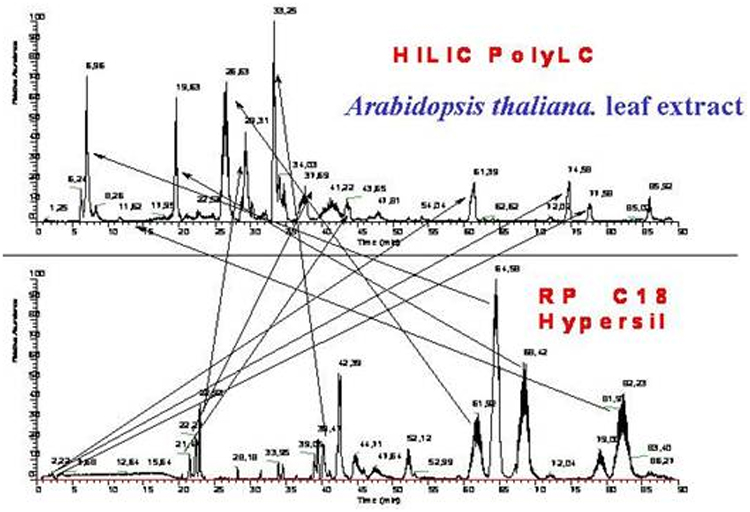
Detection is
via ESI-MS. Peaks correspond to such solutes as amino acids, anthocyanins,
oligosaccharides, glucosinolates, glycolipids, etc., as shown.
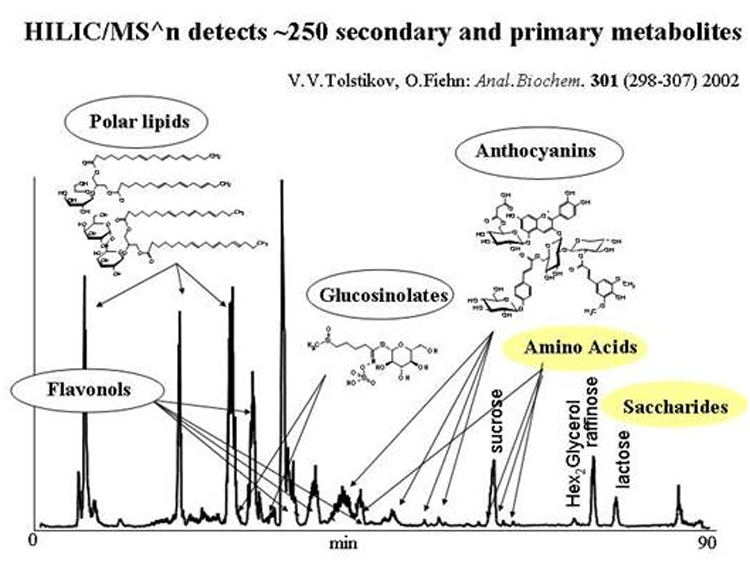
Amino Acids: Most amino acids can be resolved using routine HILIC conditions [BELOW]

Alternatively,
amino acids and other small solutes can conveniently be measured quantitatively
with a PolyHYDROXYETHYL A™ column (100-Å) using HILIC-MS/MS under isocratic
conditions. In his poster from ASMS '99, Robert Croes (DuPont Biotech)
demonstrated the measurement of amino acids in individual seeds. Analysis of
the 20 common amino acids is conveniently performed with 70% MeOH in an
ammonium formate buffer. If some metabolites of amino acids are also to be
measured [BELOW], then 60% ACN is used in place of the MeOH. This reduces MS
sensitivity but affords better chromatographic separation. This is important
with some metabolite pairs (e.g., lysine and pipecolic acid) that interfere
with each other's detection in MS/MS.
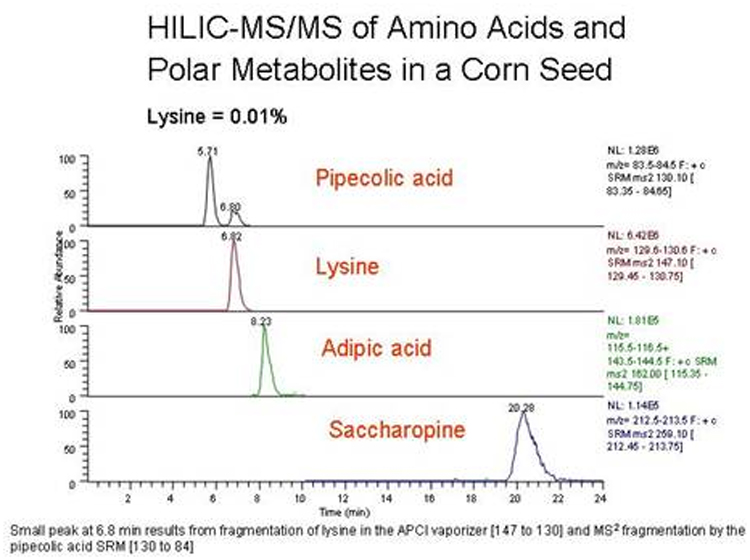
Salt
Concentrations and Extremely Polar Small Solutes: To obtain
sharp, symmetrical peaks in HILIC for small polar solutes, the following salt
levels are required in the mobile phase:
a) 10-15 mM:
Typical polar solute, such as a neutral amino acid.
b) 40 mM: Solutes with a higher charge-to-mass ratio, such as
arginine.
c) > 120 mM: Solutes with an extremely high charge, such as
ATP or aminoglycoside antibiotics.
Fortunately,
ESI-MS can tolerate up to 400 mM ammonium acetate in the mobile phase.
A plausible
explanation is that the retention of highly-charged solutes is strongly
influenced by the polarity of their counterions. A high concentration of salt
insures that all the charged groups have the same counterions. If this is not
the case, then the peak can be skewed. In an extreme case, two well-separated
peaks can be obtained for a single pure solute, corresponding to the same
solute with different counterions, with a continuum between them corresponding
to molecules that exchanged their original counterions for those in the mobile
phase during their migration through the column. This rate of exchange is slow
on the time scale of HPLC if the salt level in the mobile phase is too low.
Normally, HILIC
of small solutes is best done with a column with a high surface area;
typically, 60- or 100-Å pore diameter. However, with extremely polar solutes
such as aminoglycoside antibiotics, use of a 1000-Å material with a low
surface area facilitates elution using convenient mobile phases, as in the
following example:
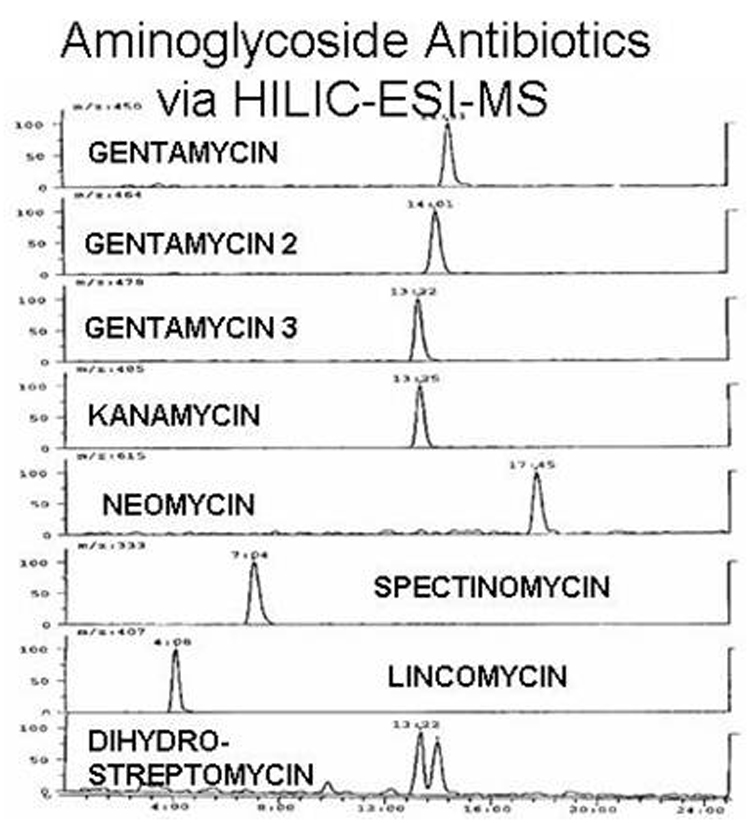
COLUMN: PolyHYDROXYETHYL A™ (Item # 204HY0510)
MOBILE PHASE: 250mM NH4OAc, pH 4, with ACN
GRADIENT: 0-5': 80-25% ACN; 5-15': 25% ACN. FLOW: 1 ml/min
Small Solutes
in Serum or Plasma: Addition of 2+
vol. of ACN to plasma or serum causes the precipitation of > 98% of the
protein while leaving most small solutes in solution. The supernatant can be
concentrated and analyzed via HILIC-MS/MS, often isocratically. This permits
high-throughput analysis of picomolar levels of drugs, metabolites, etc.
in serum or plasma. The following analysis of folates, methotrexate etc. is
from S.D. Garbis et al., Anal. Chem. 73 (2001) 5358-64:
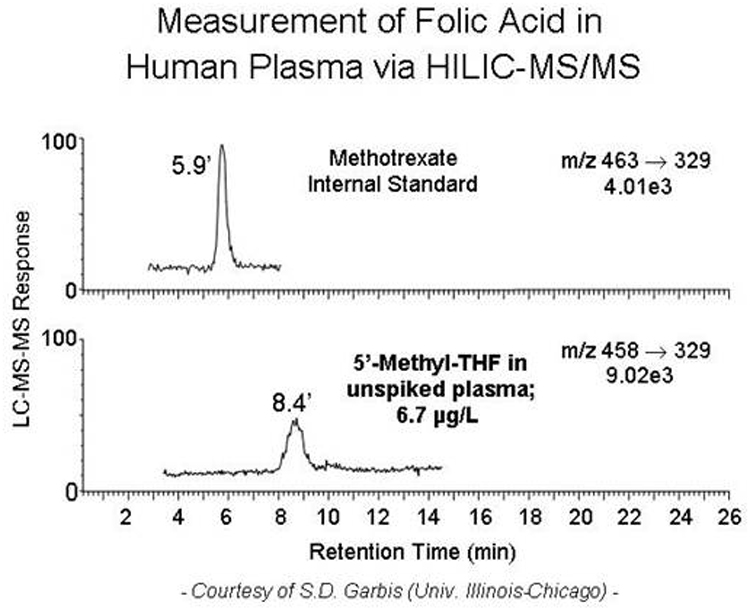
PolyHYDROXYETHYL A™ is a trademark of PolyLC Inc.
Hypersil® is a trademark of Thermo
Corp.
주소
서울특별시 송파구 충미로 5 송파한화오벨리스크 C동 415호
연락처
전화번호 : 02-3012-9003 팩스번호 : 02-3012-9010
intertech9@naver.com
사업자등록번호
215-87-83507 대표이사 : 이홍근
